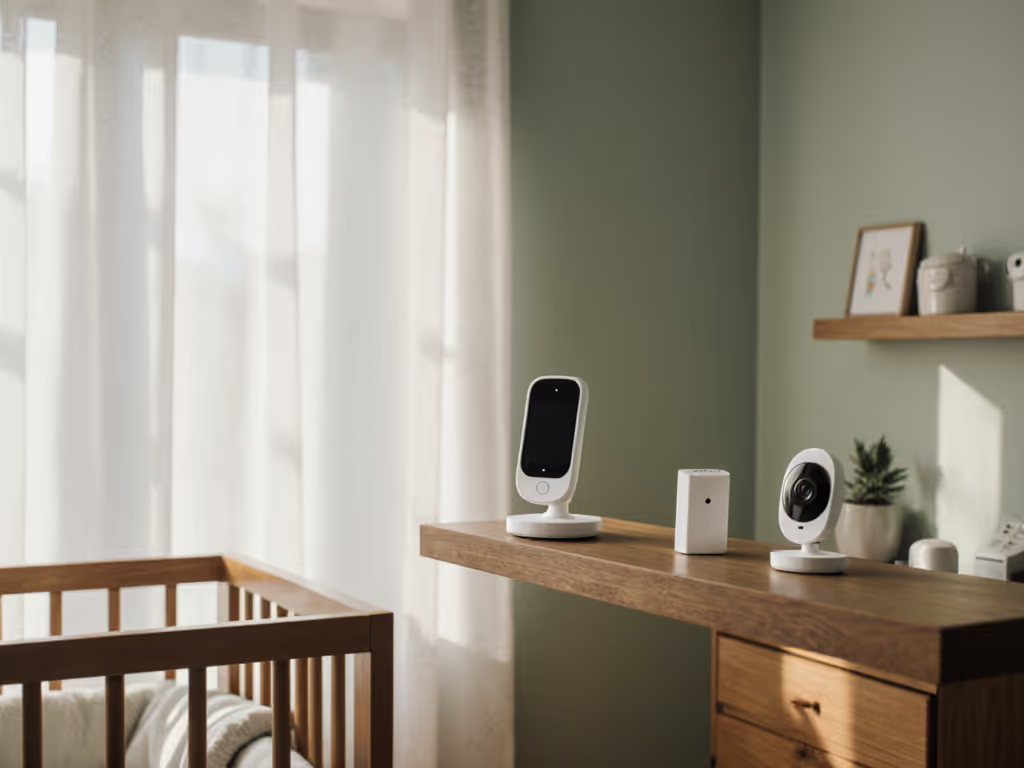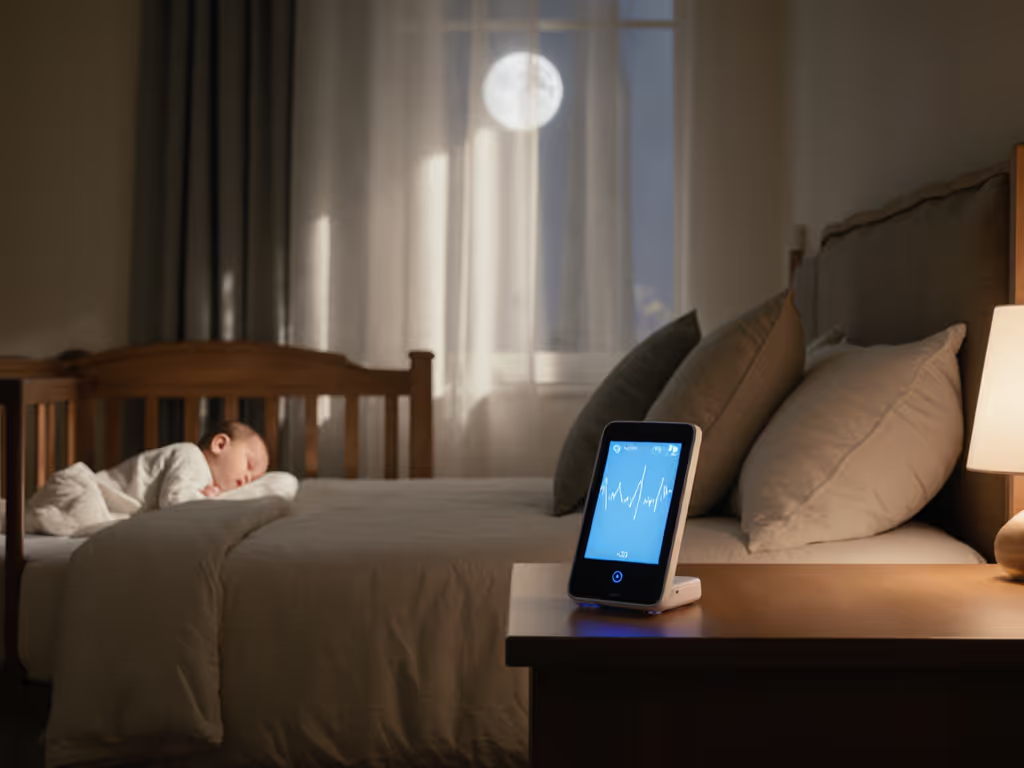
What Is Wireless Baby Monitor? Complete Overview

Did you know that over 90 percent of modern baby monitors now operate wirelessly rather than with traditional cables? For new and expecting parents, keeping a close watch on a sleeping infant without entering the room has become both a comfort and a practical necessity. With so many options and features, finding the right wireless baby monitor can make all the difference in feeling secure and connected while your child rests.
Key Takeaways
| Point | Details |
|---|---|
| Core Purpose | Wireless baby monitors provide safety monitoring, peace of mind, and responsive caregiving for infants. |
| Types of Monitors | Key categories include audio-only, digital wireless, and WiFi-enabled smart monitors, each with unique features and considerations. |
| Privacy and Security | Strong security measures, such as encryption and frequent updates, are crucial to protect against digital vulnerabilities. |
| Selection Considerations | Evaluating technical performance, privacy features, and practical use cases is essential for choosing the right monitor for your needs. |
Defining Wireless Baby Monitors and Core Purpose
A wireless baby monitor represents a technological solution designed to help parents maintain continuous visual and auditory supervision of their infants from a remote location. These sophisticated devices transmit real-time audio and video signals across wireless networks, enabling parents to observe their children without being physically present in the same room.
At their core, wireless baby monitors serve three fundamental purposes: safety monitoring, peace of mind, and responsive caregiving. By providing instant access to an infant's activities, these devices allow parents to quickly assess their child's condition, detect potential distress signals, and respond promptly to any emerging needs. Modern wireless monitors go beyond basic surveillance, incorporating advanced features like temperature tracking, movement detection, and two-way audio communication.
Key Components of Wireless Baby Monitors
Wireless baby monitors typically consist of two primary components:
- Transmitter Unit: Placed near the infant, this device captures audio and video signals
- Receiver Unit: Carried by parents, this unit displays live feed and broadcasts sound
The transmission occurs through various wireless technologies, including:
- WiFi networks
- Radio frequency (RF) signals
- Bluetooth connections
Each transmission method offers unique advantages in range, signal stability, and privacy protection. Parents can select a monitor that best matches their specific home environment and technological preferences.
Privacy and Security Considerations are paramount when selecting a wireless baby monitor. Parents must carefully evaluate devices that offer robust encryption, secure signal transmission, and protection against potential digital intrusions. The goal is not just monitoring, but ensuring a safe, private communication channel between parent and child.
Main Types of Wireless Baby Monitors Explained
Wireless baby monitors come in several distinct categories, each offering unique features and capabilities to meet diverse parental monitoring needs. Understanding these different types helps parents select the most appropriate technology for their specific home environment and childcare requirements.
Here's a comparison of the main types of wireless baby monitors:
| Type of Monitor | Key Features | Advantages | Considerations |
|---|---|---|---|
| Audio-Only | Sound transmission only | Affordable<br>Low EMR<br>Portable | No video<br>Basic security |
| Digital Wireless | Audio & video<br>Encrypted | Secure<br>Clear quality<br>Long range | Higher cost<br>Needs power source |
| WiFi-Enabled Smart | Remote streaming<br>Smart features | Remote access<br>Cloud storage<br>Smart home integration | Needs internet<br>Potential security risks |
Audio-Only Monitors
Audio-only monitors represent the most basic and traditional form of wireless baby monitoring. These devices focus solely on transmitting sound from the baby's room, allowing parents to hear their infant's movements, cries, and ambient room noise. While simple, they provide a foundational level of remote monitoring:
- Typically the most affordable option
- Lowest electromagnetic radiation emissions
- Lightweight and portable
- Ideal for budget-conscious families

Digital Wireless Monitors
Advanced digital wireless monitors offer enhanced security and signal clarity compared to traditional analog systems. These monitors use encrypted digital transmission protocols to prevent signal interference and unauthorized access. Key characteristics include:
- Secure, interference-resistant communication
- Higher sound and video quality
- Extended range of monitoring
- Additional features like temperature sensing
WiFi-Enabled Smart Monitors
WiFi-enabled monitors represent the most technologically sophisticated category, leveraging internet connectivity to provide comprehensive monitoring capabilities. These smart devices transform smartphones and tablets into advanced monitoring stations, offering unprecedented flexibility and features:
- Real-time video streaming
- Remote access from anywhere
- Cloud storage of recordings
- Integration with smart home ecosystems
While providing extensive monitoring options, WiFi monitors require careful consideration of privacy settings and potential cybersecurity risks.
![]() Parents should prioritize devices with robust encryption and secure login protocols to protect their family's digital privacy.
Parents should prioritize devices with robust encryption and secure login protocols to protect their family's digital privacy.
Essential Features and How They Work
Wireless baby monitors have evolved far beyond simple sound transmission, incorporating a sophisticated array of features designed to provide comprehensive infant monitoring. These technological marvels blend multiple sensors, communication protocols, and intelligent tracking mechanisms to give parents unprecedented insight into their child's environment and well-being.
Audio and Visual Monitoring
The fundamental core of wireless baby monitors revolves around real-time audio and video transmission. Modern devices utilize advanced digital signal processing to capture crystal-clear sound and high-definition video streams. Key audio and visual capabilities include:
- High-sensitivity microphones for detecting subtle infant sounds
- Wide-angle cameras with zoom capabilities
- Infrared night vision technology
- Automatic sound and movement detection triggers
Advanced Tracking and Sensing Technologies
Smart monitoring features transform traditional baby monitors into comprehensive health and safety tracking systems. These sophisticated technologies go beyond basic observation:
- Breathing movement detection
- Room temperature monitoring
- Humidity level tracking
- Infant sleep cycle analysis
Parents can now receive instant alerts about environmental changes or potential health concerns, creating a proactive monitoring approach that provides deeper insights into their infant's well-being.
Connectivity and Remote Access
Connectivity represents the most transformative feature of modern wireless baby monitors. Smart device integration allows parents to access monitoring feeds from smartphones, tablets, or computers, regardless of their physical location:
- Secure cloud-based streaming
- Two-way audio communication
- Mobile app notifications
- Multi-user access sharing
These connectivity features empower parents with unprecedented flexibility, enabling them to maintain visual and auditory contact with their infant while managing other responsibilities. The technology bridges physical distance, providing peace of mind through continuous, seamless monitoring.
Privacy, Security, and Connectivity Risks
Wireless baby monitors, while incredibly convenient, introduce complex digital security and privacy challenges that parents must carefully navigate. The same technology that provides peace of mind can potentially expose families to unexpected vulnerabilities if not properly managed and understood.
Digital Security Vulnerabilities
Internet-connected baby monitors represent prime targets for cybersecurity threats. Hackers can exploit weak security protocols to gain unauthorized access to live video feeds, potentially compromising family privacy and personal safety. Key digital security risks include:
- Unsecured WiFi network connections
- Default manufacturer passwords
- Outdated firmware and software
- Insufficient encryption protocols
Electromagnetic Radiation Considerations
Electromagnetic radiation represents another critical concern for parents considering wireless baby monitors. These devices continuously emit low-level radio frequencies that raise potential health questions, especially regarding prolonged infant exposure:
- Proximity to infant's developing body
- Cumulative radiation exposure
- Potential long-term biological effects
- Variation in device radiation levels
Mitigating Privacy and Security Risks
Proactive strategies can significantly reduce potential risks associated with wireless baby monitors. Parents should implement comprehensive security measures:
- Use strong, unique passwords
- Enable two-factor authentication
- Regularly update device firmware
- Choose monitors with advanced encryption
- Position monitors strategically to minimize direct radiation exposure
By understanding these risks and implementing robust protective strategies, parents can leverage the benefits of wireless baby monitors while maintaining their family's digital safety and privacy.
Key Factors When Choosing a Monitor
Selecting the right wireless baby monitor requires careful consideration of multiple interconnected factors that extend beyond basic functionality. Parents must evaluate a comprehensive range of technological, practical, and safety considerations to find a monitoring solution that perfectly matches their unique family needs and home environment.
Technical Performance Considerations
Signal reliability stands as the most critical technical factor when choosing a wireless baby monitor. Parents should assess several key technical performance attributes:
- Transmission range and signal strength
- Audio and video quality
- Interference resistance
- Battery life and charging efficiency
- Compatibility with home network infrastructure
Privacy and Security Evaluation
Modern parents must prioritize digital security when selecting a wireless baby monitor. Critical security considerations include:
- Encryption protocols
- Password protection mechanisms
- Firmware update frequency
- Cloud storage security
- Manufacturer's privacy policy
Practical and Environmental Factors
Beyond technical specifications, parents should consider practical aspects that impact daily use:
- Home layout and monitoring requirements
- Number of rooms needing coverage
- Budget constraints
- Ease of installation and user interface
- Additional smart home integration capabilities
Ultimately, the ideal wireless baby monitor balances technological sophistication with user-friendly design, providing comprehensive monitoring while maintaining robust privacy protection. Thoughtful selection ensures parents can confidently observe their infant's environment without compromising family security.
Find the Perfect Wireless Baby Monitor for Your Family
Understanding the safety, privacy, and connectivity challenges of wireless baby monitors is just the first step to giving your child the best care possible. If you worry about digital security risks, electromagnetic radiation exposure, or simply want a device that fits your home setup while offering clear audio and video, you are not alone. Many parents share these concerns and want a solution that balances advanced features like encrypted transmission and remote access with peace of mind.
At Baby Monitors for Parents, we provide expert guidance tailored specifically to your needs. Explore detailed reviews, unbiased comparisons, and proven tips that focus on privacy and ease of use. Don’t let confusion about WiFi-enabled versus digital wireless monitors hold you back. Visit our landing page now and take control of your infant's safety. Act today and empower yourself with trusted information that turns complexity into confidence.
Frequently Asked Questions
What is a wireless baby monitor?
A wireless baby monitor is a device that allows parents to remotely monitor their infant's audio and video from another room using wireless technology, such as WiFi, radio frequency, or Bluetooth.
What are the main types of wireless baby monitors?
The main types of wireless baby monitors include audio-only monitors, digital wireless monitors, and WiFi-enabled smart monitors, each offering different features and functionalities for varying parental needs.
How do I ensure the privacy and security of my wireless baby monitor?
To ensure privacy and security, choose monitors with strong encryption, use unique passwords, regularly update device firmware, and position the monitors to minimize direct radiation exposure.
What essential features should I look for in a wireless baby monitor?
Key features to consider include audio and video quality, range, connectivity options (like smart device integration), advanced tracking capabilities (such as temperature monitoring), and two-way audio communication.





